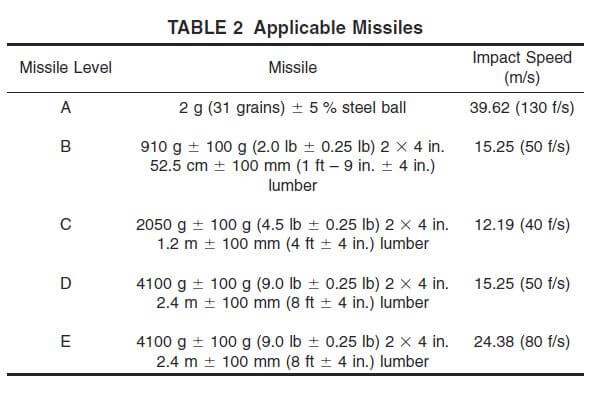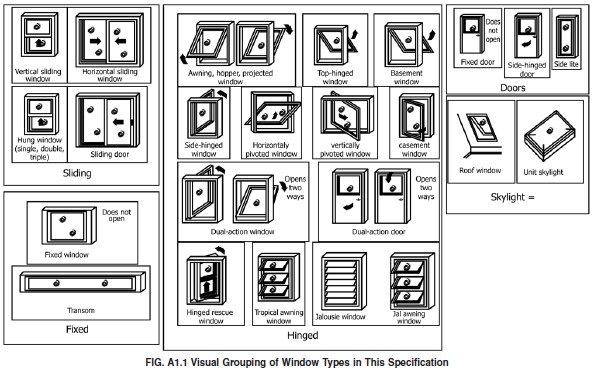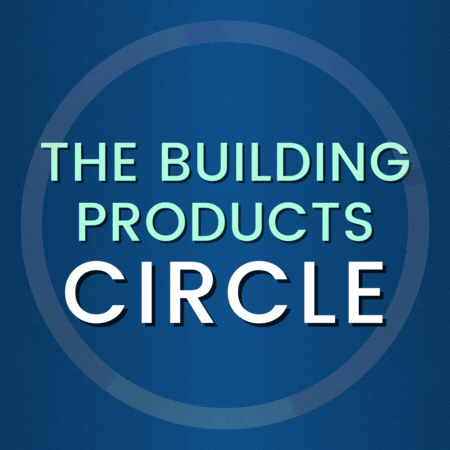Overview
As of the 2020 Florida Building Code & 2018 International Building Code, ASTM E1996-17 is the adopted reference standard. The title is ‘Standard Specification for Performance of Exterior Windows, Curtain Walls, Doors, & Impact Protective Systems Impacted by Windborne Debris in Hurricanes’. (Exterior garage doors & rolling doors are covered by ANSI/DASMA 115 & not part of this specification).
ASTM E-1996 breaks down impact resistance into (5) levels, A through E.
Missile Level A is better known as ‘small missile impact’ – a 2g steel ball shot at 130 ft/second in a prescribed array.
Missile Level B isn’t used in wall wind zones but appears for skylights listed below. It represents a 2.0lb 2 X 4 at 50 ft/second shot at a prescribed pattern to glazing. You can see from table 3 below missile level B isn’t referenced in any of the current 3 wind zones.
Missile Level C is known as ‘medium missile impact’ – a 4.0lb 2 X 4 shot at 40 ft/second in a prescribed pattern. It’s used in wind zones 1 & 2 below for basic protection & is not all that common.
Missile Level D is the most common & represents ‘large missile impact’ known to protect against the strongest of hurricanes. It represents a 9lb 2 X 4 shot at 50 ft/second. Most storm protection systems for residential & commercial structures meet this standard & is applied to a certain portion of the building (typically below 30′ but with exceptions) in wind zones 1, 2, or 3 as described below.
Missile Level E is enhanced impact protection & represents a 9lb 2 X 4 shot at a prescribed pattern at 80 ft/second at glazed surfaces. More on this is below.
ASTM E-1996 focuses on the testing protocol of these missile levels.
More on ASTM Missile Level E
From section 6.2.1.1: Enhanced Protection (Essential Facilities): Buildings and other structures designated as essential facilities, including but not limited to hospitals, other health care facilities having emergency treatment facilities, jails and detention facilities, fire, rescue and police stations, and emergency vehicle garages, designated emergency shelters, communications centers and other facilities required for emergency response, power generating stations, other public utility facilities required in an emergency, and buildings and other structures having critical national defense functions.
6.2.1.2 Basic Protection: All buildings and structures except those listed in 6.2.1.1 and 6.2.1.3.
6.2.1.3 Unprotected: Buildings and other structures that represent a low hazard to human life in a windstorm including but not limited to agricultural facilities, production greenhouses, certain temporary facilities, and storage facilities.
For requirements of essential facilities described, click here.


Important to note that ASTM E-1996 wind zone ‘4’ was removed from the 209 standard and does not appear in the 2014 or 2017 standards.
Wind zone wind velocities are defined as follows:
(ASCE/SEI 7 Vult)
Wind Zone 1—130 mph – 139 mph
Wind Zone 2—140 mph – 149 mph more than a mile away from shoreline.
Wind Zone 3— =/>150 mph or >= 140mph within 1 mile of the coastline measured from the mean high water mark.
ASTM E-1996-17 also lists the impact locations for various types of windows. For illustrative purposes only, this is an idea of what the missile locations involve for various window types as listed in the standard:

Important to note for alternate glass sizes is Annex A1.3.2.1: A1.3.2.1 For curtain wall and storefront:
Any substitution of an assembly of the same type as the three initial specimens shall be allowed automatically, provided: (1) the infill elements are equal to or smaller in overall area, and (2) the rating is at equal or lower design pressures. Assemblies are allowed automatically to be stretched in one dimension only, provided
(1) the overall area of the originally tested specimens is not exceeded,
(2) the deflection and stress limits of any structural member or component is not exceeded, and
(3) the rating of the originally tested specimens is not exceeded.
Testing of additional specimen sizes can be conducted to override these limitations.
For substitution of framing materials:
Refer to annex A1.12:
A1.12.1 For all wind zones, any substitution of framing materials on the basis of a single specimen test shall require infill impacts as shown in A1.4. Any such substitution by users
of Appendix X4, Additional Protection, shall require additional impacts in accordance with the locations specified in X4.4.2.1 and X4.4.2.2.
A1.12.2 The substitution profile section moduli and moments of inertia must be greater than or equal to the original profile tested as evaluated in accordance with standard engineering practices.
A1.12.3 Any substitution within the material of the framing, sash, panel, or door leaf must maintain the same glazing design, detail, and glass bite as originally tested.
This is in no way a comprehensive review of this standard. For designers & manufacturers interested in learning more, it is recommended that you purchase the full standard by Clicking Here
Last Update: March 31, 2021
